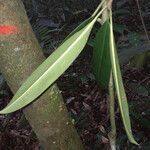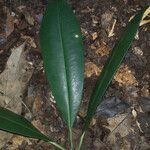Tree to 35 m. Leaves with petioles 1.3-4.2 cm long; blades narrowly obovate or sometimes elliptic, obtuse or rounded to shallowly emarginate or short-acu-minate, 6-30 cm long, 3-12 cm broad, glabrous, the primary laterals fine and rather closely spaced, occasionally subobscure. Flowers 3-12 per fascicle, the fas-cicles axillary to both leaves and leaf-scars; pedicels glabrous, 1.2-3 cm long; sepals ovate or ovate-oblong, 4-6 mm long, the inner minutely appressed-sericeous, the outer soon glabrate; corolla 5-7 mm long, subrotate, the tube ca 1/5 the total length, the lobes narrowly elliptic-lanceolate, the dorsal appendages as broad as and usually slightly longer than the lobes, free from the lobes to the tube, distally divided for ca 2/3 of their length into 2 or 3 slender lanceolate segments; staminodes 1.2-3 mm long, ovate-lanceolate, erose; staminal filaments equalling or slightly exceeding the staminodes; ovary glabrate, the style glabrous, 4-5 mm long. Fruit smooth or slightly roughened, globose or ellipsoid-globose, 2-3.5 cm long.
More
A large tree. It can grow 35 m high. The trunk is large and there are small buttresses. The bark has vertical cracks. The leaves are simple and alternate. The leaves are tightly bunched at the ends of the branches. The leaves are 6-30 cm long by 3-12 cm wide. The leaves are shiny green above and light brown underneath. The flowers are small and white or yellow. The fruit are round with a small tip. They turn orange when ripe. There are one or two seeds. The are dark brown with a light brown patch. They are a flattened oval shaped and 2 cm long by 1 cm wide.


